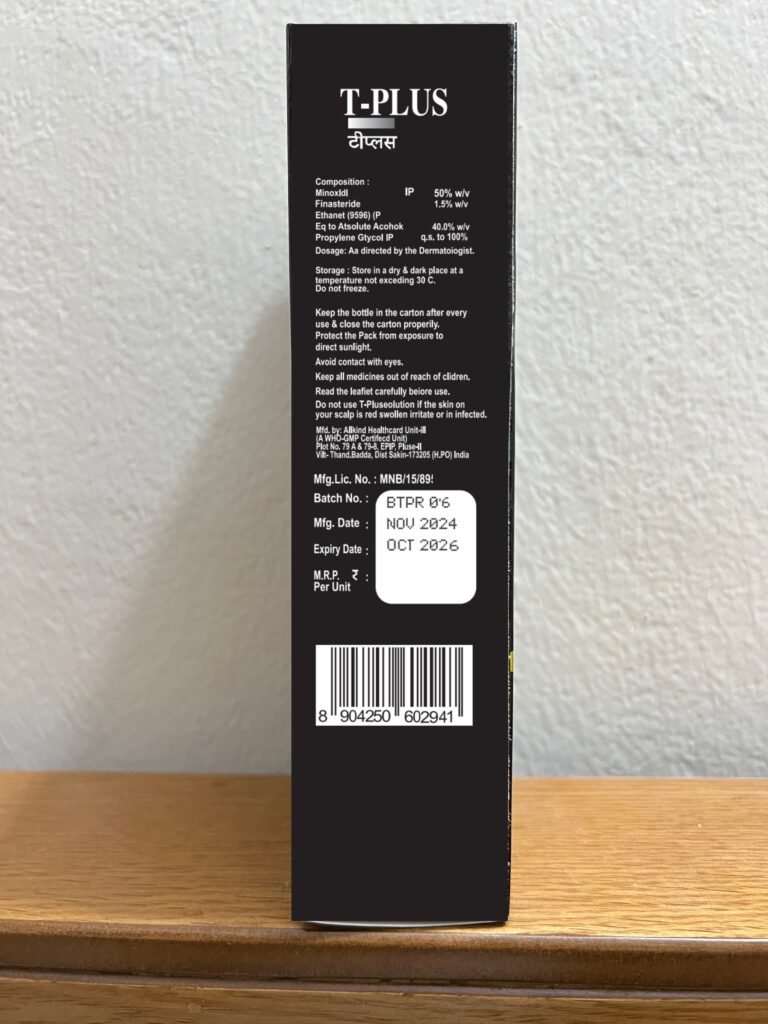Finasteride vs. Minoxidil: A Comprehensive Guide to Hair Loss Treatments
T-Plus Minoxidil is a solution for hair loss for both men and women. Both minoxidil and finasteride, two well-liked therapies for hair loss, stimulate hair growth in different ways. To address their hair loss, some individuals opt to use both treatments in combination. Does this strategy, however, work for you?
All you need to know in this article:
Everything you should know about minoxidil and finasteride: How they function, how they differ from one another, and how combining treatments can result in more successful regeneration
Effective Hair Loss Treatment Techniques: How do you use your treatment now that you’ve received it? Learn how to maximize your hair regrowth regimen, from first-time users to post-hair transplant care.
Advantages and disadvantages: Learn about the potential side effects, advantages, and what to anticipate if you quit using finasteride and minoxidil for hair loss.

What’s the Difference Between Finasteride and Minoxidil?
Finasteride and minoxidil serve distinct roles in combating hair loss.
- Finasteride is an oral medication that inhibits 5-alpha-reductase, the enzyme responsible for converting testosterone into dihydrotestosterone (DHT). Since DHT shrinks hair follicles, reducing its levels helps prevent further hair loss and may promote regrowth.
- Minoxidil (including T-Plus Minoxidil) is a topical solution that stimulates blood flow to hair follicles, prolonging the growth phase (anagen) and revitalizing dormant follicles. Unlike finasteride, it doesn’t affect hormones.
While finasteride addresses the root cause of androgenetic alopecia, minoxidil enhances follicle health externally.
Can You Use Finasteride and Minoxidil Together?

Absolutely. Combining these treatments leverages their complementary mechanisms. Finasteride stops further hair loss by blocking DHT, while T-Plus Minoxidil boosts regrowth by improving follicle function. Studies show that pairing them yields better results than using either alone.
How Do Finasteride and Minoxidil Work Together to Increase Effectiveness?
The synergy between finasteride and T-Plus Minoxidil creates a multi-pronged attack on hair loss:
- DHT Suppression – Finasteride minimizes follicle damage.
- Enhanced Circulation – Minoxidil delivers nutrients to hair roots.
- Prolonged Growth Phase – Minoxidil extends the anagen phase, while finasteride prevents miniaturization.
This dual approach maximizes hair retention and regrowth potential.
How to Use Finasteride and Minoxidil

Daily Routine for Using Finasteride and Minoxidil Together
- Finasteride: Take 1 mg orally per day, preferably at the same time.
- T-Plus Minoxidil: Apply 1 mL twice daily (morning and night) to the scalp. Massage gently for absorption.
Consistency is key—skipping doses reduces efficacy.
How Long Do Finasteride and Minoxidil Take to Work?
- Finasteride: Visible results typically appear after 3–6 months, with peak effectiveness at 1–2 years.
- T-Plus Minoxidil: Initial shedding may occur within 2–8 weeks, followed by noticeable regrowth at 4–6 months.
Patience is crucial; hair growth is a slow process. How Long Should I Take Finasteride and Minoxidil Together?
Hair loss is chronic, so long-term use is necessary. Discontinuing either treatment may reverse gains:
- Stopping finasteride allows DHT to damage follicles again.
- Quitting T-Plus Minoxidil may cause hair to revert to its prior thinning state.
For sustained results, commit to ongoing use unless side effects arise.
Relevant Post: T-Plus Minoxidil 5%: Faster Hair Growth & Thickness Solution
Using Finasteride and Minoxidil After a Hair Transplant
Post-transplant, these treatments protect existing hair and enhance graft survival.
- Finasteride prevents further loss in non-transplanted areas.
- T-Plus Minoxidil can accelerate healing and boost density.
Consult your surgeon before resuming treatment.
Side Effects of Using Finasteride and Minoxidil Together
Most users tolerate the combination well, but potential side effects include:
Finasteride
- Decreased libido
- Erectile dysfunction (rare)
- Breast tenderness
T-Plus Minoxidil
- Scalp irritation
- Unwanted facial hair (if applied improperly)
- Temporary shedding
Side effects usually subside with continued use.
Does Using Minoxidil and Finasteride Together Cause Erectile Dysfunction?
Finasteride carries a low risk of sexual side effects (reported in <2% of users). T-Plus Minoxidil does not affect hormones, so combining them doesn’t increase this risk. Most men experience no issues, but discontinuing finasteride reverses any problems if they occur.
What Happens When You Stop Using Finasteride and Minoxidil?
- Finasteride withdrawal: DHT levels rebound, triggering hair loss within 6–12 months.
- Minoxidil cessation: Shedding begins around 3–4 months, with hair returning to baseline.
To maintain results, continuous treatment is essential.
Alternative Hair Loss Treatments
If finasteride or T-Plus Minoxidil aren’t suitable, consider:
- Low-level laser therapy (LLLT)
- Dutasteride (stronger DHT blocker)
- PRP therapy (platelet-rich plasma injections)
- Natural remedies (saw palmetto, rosemary oil)
Which Hair Loss Treatment Is Right for Me?
Choosing between finasteride, T-Plus Minoxidil, or both depends on:
- Cause of hair loss (DHT-related vs. circulation issues)
- Preferred application (oral vs. topical)
- Tolerance for side effects
Take Control of Your Hair Loss Today!
Struggling with thinning hair? Combining finasteride and T-Plus Minoxidil could be your solution for thicker, healthier hair.
🔹 See visible results in months
🔹 Clinically proven to combat hair loss
🔹 Easy to use with minimal side effects
Don’t wait – your confidence starts here! Consult your dermatologist about starting this powerful hair regrowth combo today.

